Albino African clawed frogs are large, strange-looking aquatic frogs.
Albino clawed frogs belong to the same species as the African clawed frog Xenopus laevis.
Like most albino animals, they are pretty rare in the wild.
Due to the ease of breeding clawed frogs in captivity, these oddball albino frogs have become prevalent in the pet trade.
As a fully aquatic species, clawed frogs have extremely different care requirements to terrestrial amphibians.
The albino African frog has the same care requirements as its “wild-type” relatives.
In This Article
What You’ll Learn
In this article, we’ll answer questions about all aspects of albino African clawed frog care and husbandry, including:
- What is albinism?
- Do albino frogs require special care?
- Can albino clawed frogs be handled?
- Do albino clawed frogs require land?
- Are albino clawed frogs a separate species?
We’ll also provide information to help you properly care for a clawed frog, such as:
- Clawed frog background information
- Tips for buying a healthy clawed frog
- How to set up a clawed frog aquarium
- How (and what) to feed your clawed frog
- How to maintain your frog’s water quality
…and much more!
Albino African Clawed Frog Background Information
African clawed frogs (Xenopus laevis) – also known as clawed frogs – are aquatic frogs in the family “Pipidae.”
Clawed frogs are aggressive predators. They’re named for their clawed feet, which they use to tear apart their prey.
Albino clawed frogs look quite different from their pigmented counterparts. We’ll talk all about the species and the albino variant in this section.
What Is Albinism?
Albinism is a rare genetic mutation that causes a complete lack of skin pigmentation.
This mutation causes animals to appear white, pink, or translucent, with red or blue eyes.
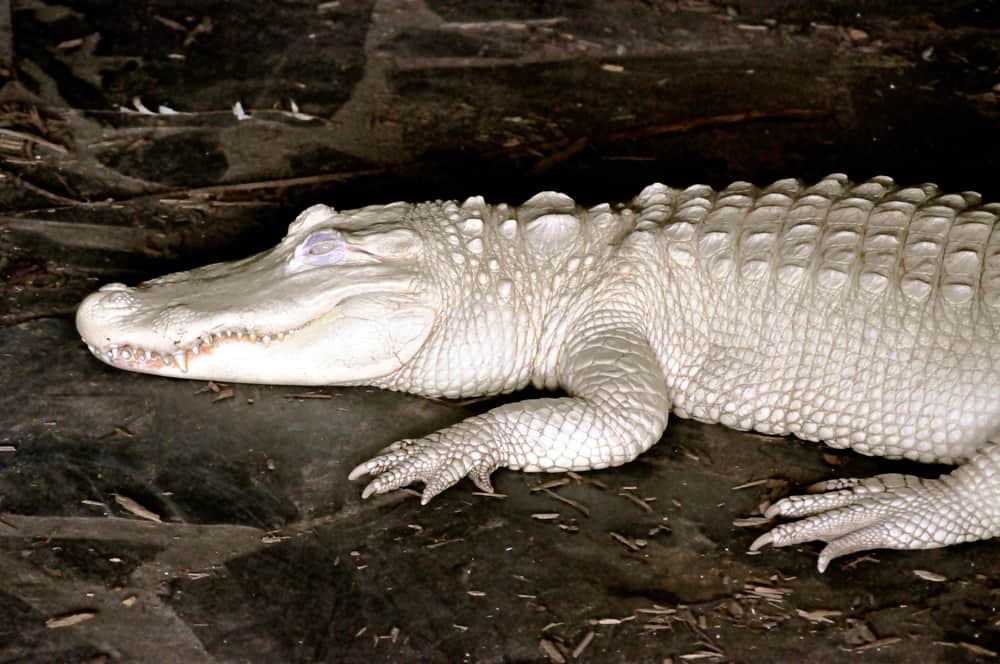
Albinism is a heritable trait, meaning that parents can pass it to their offspring.
It’s usually associated with health issues such as increased UV sensitivity and abnormal eye development.
It can also cause wild animals to be more visible to predators – making them easy prey!
Because this trait usually hinders survival, albino animals rarely pass on their genes in the wild. That’s why you rarely see albinism in wildlife.
In captivity, it’s easy to breed albino animals to produce albino offspring. Private collectors and zoos often idolize albino animals.
Description
Clawed frogs are among the most unusual looking of all frogs due to their squat, flattened body shape.
Their hindlimbs are large and powerful with distinct, black “claws.” Their forelimbs are much smaller.
They also possess a pair of prominent, beady eyes that face upwards.
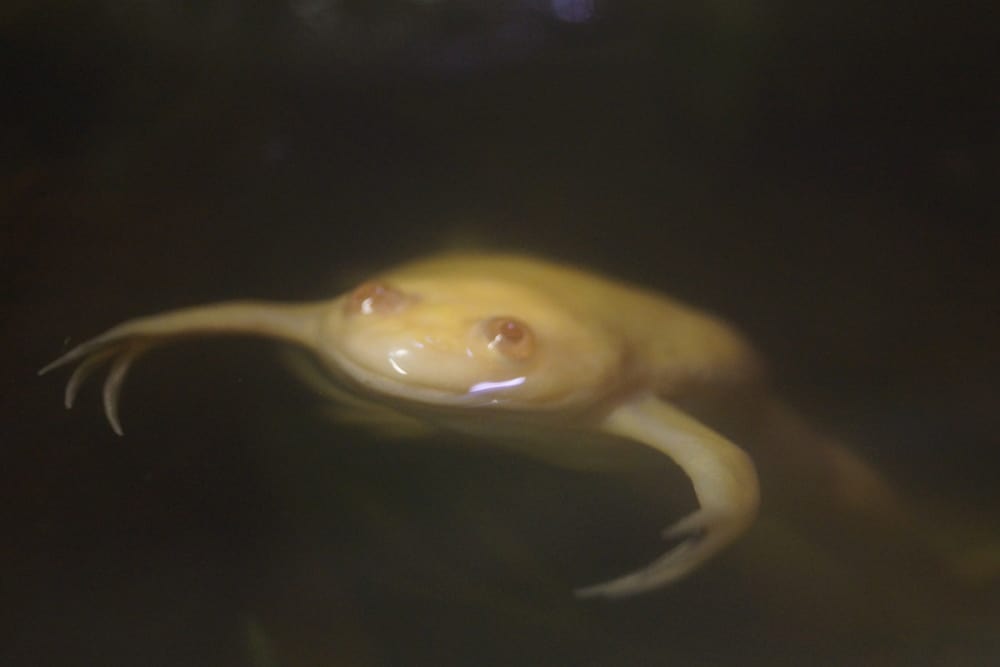
Their smooth, shiny skin is usually olive green or grey. Albino frogs are cream or light pink.
Albino clawed frogs can be mistaken for albino African dwarf frogs but differ significantly in size (the clawed frog being much larger).
Clawed frogs also lack webbing on the front feet. They have eyes on top of their heads, rather than at either side.
Habitat and Ecology
As their name suggests, African clawed frogs are native to Africa.
They inhabit freshwater habitats – often shallow pools in otherwise-arid landscapes – throughout Sub-Saharan regions.
They can also bury themselves in mud to preserve moisture during droughts, a behavior known as estivation.
These frogs are adapted to an aquatic lifestyle and can move quickly using their powerful legs.
They’re voracious, generalist predators, feeding on a range of aquatic invertebrates and small fish.
The species also has a strong tendency towards cannibalism, feeding on their larvae in a pinch!
Fun Fact: Some scientists believe that cannibalism may be critical to this ruthless frog’s success in certain environments. Xenopus tadpoles feed on plankton, which is abundant in most water bodies – even when other life is virtually absent. By surviving on the tadpoles of their own species, adult frogs can colonize relatively barren aquatic habitats.
Reproduction
Clawed frogs can reproduce throughout the year. Seasonal changes in rainfall and temperature control their reproductive cycle.
In captivity, keepers can artificially induce breeding behavior by adding cool water to the enclosure.
Conservation
Xenopus laevis is listed as a species of “Least Concern” on the IUCN Red List.
This designation means that these animals currently face little or no threat of extinction in the wild.
Data indicate that populations may actually be increasing in size throughout their native range.
Clawed frogs are considered an invasive species in several countries, such as the USA, UK, and France.
This designation is due to their ability to colonize a range of different water bodies.
Once introduced to a system, they can wreak havoc on local wildlife due to their aggressive, predatory nature.
Albino African Clawed Frog Size
Clawed frogs are relatively large amphibians.
They’re also sexually dimorphic, with females being the larger sex.
Adult female clawed frogs typically measure between two and six inches (snout to vent).
Male frogs top out at around four inches.
Albino African clawed frog size is no different from the wild-type size.
Albino African Clawed Frog Lifespan
African clawed frogs live for an average of 10-15 years in captivity.
With excellent husbandry, some specimens can even live as long as 20 years!
Albino African clawed frog lifespan does not differ from wild-type African clawed frog lifespan.
Buying a Healthy Albino African Clawed Frog
Albino African clawed frogs are among the most common pet store amphibians. You’ll find them online and in most stores offering aquatic animals.
When purchasing your frog, look for signs of good health.
A healthy frog should be:
- Active (swimming around the enclosure)
- A reasonable weight (not obese or emaciated)
- Lacking injuries (with all four limbs and both eyes)
- Free of fungal growth or discoloration (no fuzzy or white patches on the skin)
African Clawed Frog Tank Size
These frogs are active and grow to be quite large. They require quite a bit of space to roam around, and a larger aquarium is beneficial.
We recommend an African clawed frog tank size of AT LEAST ten gallons.
An aquarium of 15 gallons or more will allow you to house two or three frogs together. Avoid overcrowding, which can cause unsanitary conditions, stress, and disease.
Environmental Requirements
As aquatic amphibians, these frogs do have some specific needs that set them apart from other animals.
In this section, we’ll discuss the factors that make a hospitable environment for clawed frogs.
Do African Clawed Frogs Need Land?
As fully aquatic frogs, these animals don’t require access to land.
They do need to breathe air and must be housed in water no deeper than 12 inches. In deeper water, clawed frogs struggle to reach the surface and may drown.
Water should be deep enough to allow frogs plenty of space to submerge and swim freely.
Aquarium Specifics
As mentioned earlier, your tank should not be less than ten gallons in size or deeper than 12 inches.
Tanks must also have a secure lid, as these frogs are skilled escape artists.
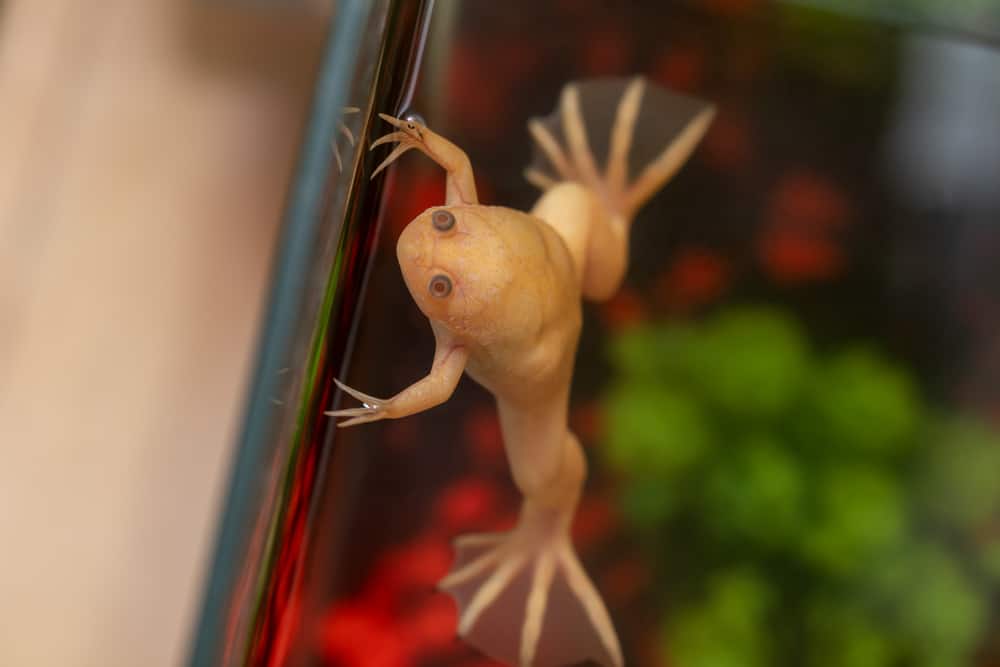
Temperature
These animals thrive around room temperature, with an optimal range of 65 to 75 degrees Fahrenheit.
This range means that most setups require no special heating apparatus.
We still recommend including a thermometer and ensuring that your tank never leaves this range.
Water Conditions and pH
Clawed frogs require an aquarium pH within the range of 6.0-7.8.
These frogs are also susceptible to certain chemicals.
Never expose them to chlorine (always use distilled water as opposed to tap water).
It’s also vital to ensure that no metal is placed in contact with their water, as metal ions are toxic to clawed frogs.
Aquarium Substrate
The substrate is the material that covers the base of an aquarium. It helps to absorb detritus and support a community of helpful microorganisms.
Unlike most amphibians, clawed frogs can live on a gravel substrate.
It’s important to note that not all gravel is suitable, as small particles can be ingested accidentally and cause health issues.
Only use gravel with medium or large particles, as these are difficult to ingest. Never use sand or small-particle gravel as a substrate for clawed frogs.
Also, ensure that your aquarium gravel is rinsed thoroughly before use.
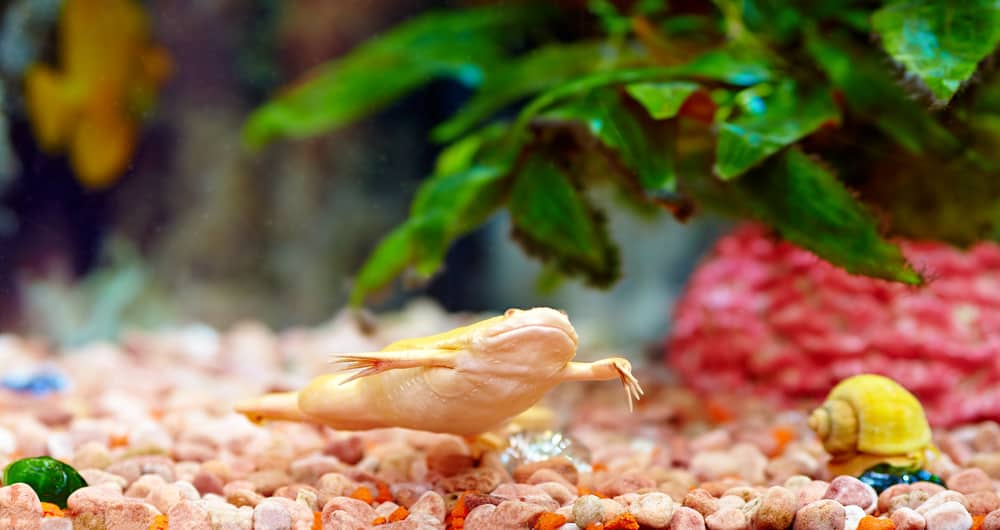
Lighting
These frogs don’t require any special lighting.
They do require a consistent, 12-hour day/night cycle.
Fluorescent aquarium lights can serve to illuminate your frog for viewing or display purposes (but aren’t essential unless there are live plants in your tank).
If you do use lights, be sure to switch them off overnight.
Filtration
A filtration system is not essential if water is changed regularly. Gentle filtration can help to maintain water quality and keep your tank clean.
Noisy filters can lead to chronic stress, so ensure that any model you choose is relatively quiet and doesn’t disturb the water too much.
Tank Accessories
Hides are essential for this species to prevent stress and provide enrichment.
Provide a variety of aquarium-safe hides such as caves or tunnels to help your frog feel safe.
Plants are another great tool to introduce hiding places to an aquarium. They also add to the visual appeal of your tank.
Note that you will need specific lighting to keep aquarium plants alive.
Compatible Tank Mates
These frogs are voracious predators and will eat anything small enough to fit in their mouths, including fish, crustaceans, and other amphibians.
To avoid any issues, house frogs ONLY with other, similarly-sized frogs.
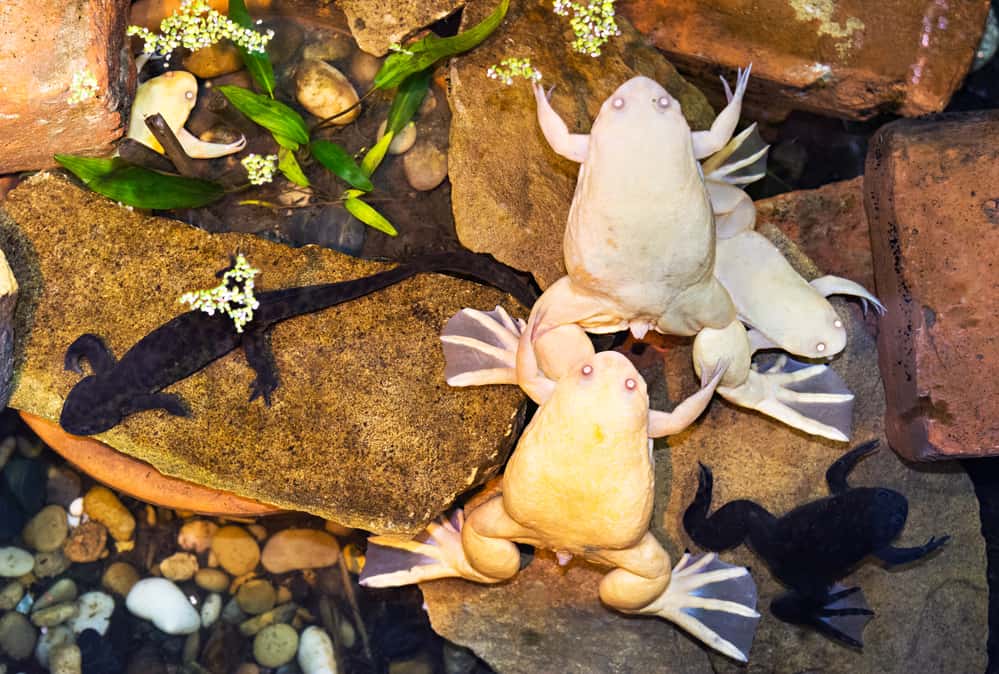
Albino African Clawed Frog Care
Albino frogs don’t require any specific care as a result of their albinism.
They do require regular water changes and tank maintenance. For their size, they can produce a fair amount of waste. It’s essential to keep your tank clean to prevent disease.
We recommend performing a partial water change (around 20%) every week. Remember to use distilled or dechlorinated water ONLY.
During each weekly water change, use an aquarium siphon to clean detritus from your gravel substrate. You’ll also need to scrub any algae from your aquarium walls.
Feeding African Clawed Frogs
Feed your clawed frogs daily.
They have slightly different needs from what do other frogs eat.
As with most animals, offering a diverse variety of foods is key to good health and longevity.
You can keep clawed frogs on a diet of formulated pellets, but it’s best to feed them a more diverse diet if possible.
You’ll find pellets formulated for these frogs online and in some specialist pet stores.
In addition to – or in place of – a pellet-based diet, you can feed your frogs a mix of the following:
- Bloodworms
- Brine shrimp
- Tubifex worms
As occasional treats, you can also offer waxworms, earthworms, or small feeder fish.
Live foods (as opposed to thawed options) invoke a stronger feeding response and provide behavioral enrichment. We recommend a mix of both for your clawed frogs.
Common Health Issues
African clawed frogs are a hardy species overall. They do well in captivity and are resistant to disease.
Like any animal, however, they can encounter some health issues that need to be kept in check.
In this section, we’ll briefly outline the symptoms, causes, and treatments/preventative measures for their most common ailments.
Dropsy (Edema)
Symptoms: Severe, balloon-like bodily swelling. Frogs with dropsy are likely to become lethargic and unwilling to feed.
Causes: Unknown.
Best Course of Action: Seek veterinary assistance immediately.
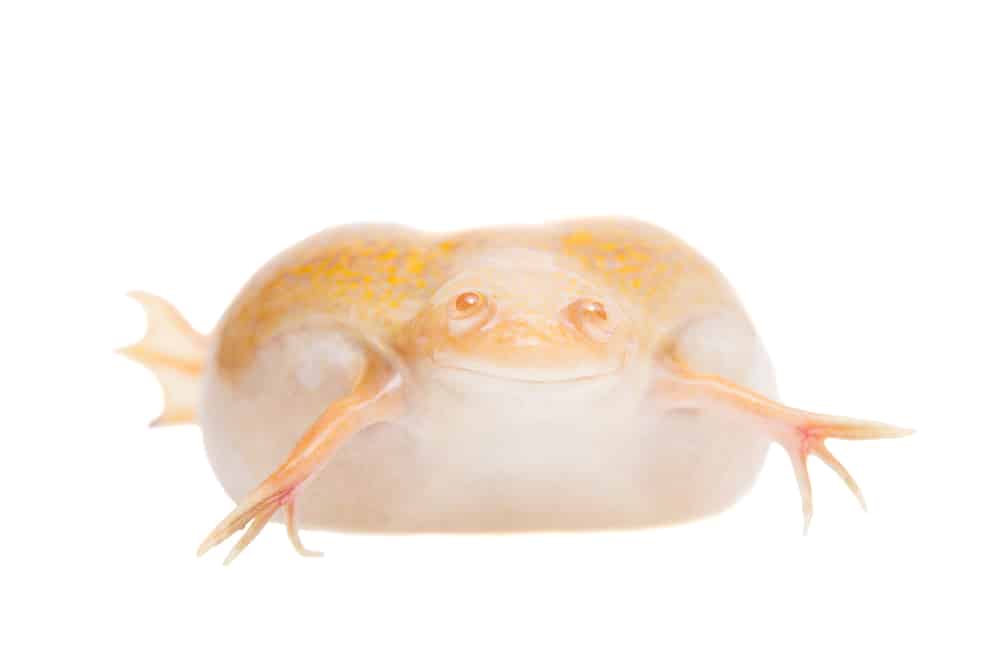
Skin Infection
Symptoms: Discolored or “fuzzy” patches on the skin. Lethargy. Unwillingness to feed.
Causes: Pathogenic fungus or bacteria. Often related to crowded conditions or poor water quality.
Best Course of Action: Seek veterinary assistance for treatment advice.
NOTE: It’s normal for frogs to shed their skin around once per month. The skin should slough off entirely within around a week.
Handling African Clawed Frogs
Do NOT handle your African clawed frogs. It’s highly stressful for aquatic animals to leave their habitat.
These frogs also have a slippery outer coating that makes gripping them extremely difficult.
If you were to attempt to handle these frogs, you’d most likely end up dropping them and causing a fatal injury.
If you’re looking for a frog that takes well to handling, a White’s tree frog would be a better choice of pet.
You can learn all about White’s tree frog care here.
Do Albino Clawed Frogs Make Good Pets?
Albino clawed frogs are an ethereal, almost alien-looking species with relatively simple care requirements.
Though they aren’t suitable for handling, these animals are indeed interesting to look at. If you’re looking for a quirky, unusual display animal – these may be the frogs for you!
To learn about another odd-looking display frog that is well-suited for beginners, check out our chubby frog care guide or our list of the best pet frogs for beginners and experts alike!
Do you have an albino clawed frog? Show us your frogs in the comment section!
